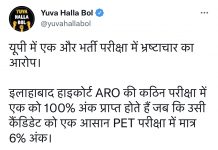— Himanshu Thakkar —
People of Bundelkhand certainly need better water access and management as claimed in the Media Briefing Note on the occasion of Union Cabinet clearing the project on Dec 8, 2021. But the Ken Betwa Link Project (KBLP) is not for Bundelkhand, of Bundelkhand or by Bundelkhand. The project will bring unbelievably huge adverse impacts for the Bundelkhand and promises benefits that were promised decades ago, but never realised. In fact much better, cheaper, less impactful and faster options for Bundelkhand exist, if only the government had the will.
Law of the land says that before taking up a project for implementation, it must have all the required clearances including Forest Clearance, Wildlife clearance and any pending legal challenges are resolved. In case of KBLP, it does not final forest clearance, very fundamental questions have been raised about its Wildlife Clearance by the Central Empowered Committee (CEC) of the Supreme Court and SC has yet to take a decision on it, a legal challenge to the Environment Clearance (EC) is pending before the National Green Tribunal. If law of the land is to prevail, the cabinet should not have cleared the project. But a decision was taken purely on political consideration of gaining some electoral benefit in the upcoming Uttar Pradesh assembly elections, the BJP government’s cabinet decided to clear the disastrous project.
The cabinet decision raises the proprietary question, if the cabinet should be endorsing a project that does not have all the statutory clearances and legal challenge to its available clearances is pending before the various judicial bodies? What signal is the Prime Minister & the cabinet sending, what kind of pressures does this endorsement brings on the statutory and judicial decision makers?
In a most path breaking, remarkable report submitted to the Supreme Court on the KBLP on Aug 30, 2019, the CEC has raised fundamental questions not only on the appropriateness of the Wildlife Clearance given to the project, but also the viability, optimality and desirability of the project. It said the project will lead to “the loss of 10500 ha of wildlife habitat in PTR”, in addition to submergence of 9000 ha of the Panna Tiger Reserve (PTR).
The Detailed Project Report of KBLP prepared by the project proponent National Water Development Agency (NWDA) says: “The main objective of the Ken-Betwa link project is to make available water to water deficit areas of upper Betwa basin… ” That upper Betwa region is outside the Bundelkhand & has higher rainfall than Bundelkhand. Most areas of Bundelkhand that are now promised water from KBLP are either already getting water from other existing projects or were made similar promises decades back, the promises remain unrealised. Both the Forest Advisory Committee (FAC) and CEC conclude that the NWDA has not examined the alternatives to the project.
As the then Panna Collector wrote, Panna district, one of the least irrigated areas of Madhya Pradesh, will suffer maximum destruction, while getting very little benefit. Downstream Banda district of UP will suffer such huge impacts that at one stage Principle Secretary of UP wrote in an affidavit before the Supreme Court that the project will bring social unrest in the state!
The project is based on the premise that Ken, the smaller of the two rivers, has surplus water that can be transferred to bigger Betwa river. But the hydrological data that is claimed to support that premise is not in public domain, has never been put to scrutiny by any independent credible agency. Ground realities and available facts show that the hydrological basis of the project is a secret exercise in manipulation.
The CEC report raises the question about the current and future water needs of the Upper Ken basin, which has clearly been ignored. The project is likely to keep this mostly tribal area permanently backward. Ken Basin and Bundelkhand are asked to pay that price for past blunders of irrigation engineers in Betwa basin, as CEC report says: “This faulty planning in development of irrigation facilities in lower Betwa basin at the cost of Upper Betwa basin is proposed to be now rectified by substitution of water from Ken basin.”
In this context the FAC made a very important suggestion that has never been implemented: “It is suggested that a team of independent experts on surface water hydrology, drawn from leading scientific institutions, should have been requested to examine the hydrological aspects of the Ken Betwa river link”. Why is the government afraid of such an independent scrutiny of hydrological foundation of such a expensive and impactful project? Clearly it has a lot to hide.
The CEC report also shows that the KBLP will have much larger impact on PTR than assessed as the East West corridor of movement within PTR will no longer be available.
The CEC has concluded that the Standing Committee of National Board of Wildlife has not examined the “Impact of the project on the downstream Gharial Sanctuary and the vulture nesting sites”, “not given due consideration to the critical observations of the Committee of SC NBWL” and “not taken into account the decision of this Hon’ble court in lA No. 100 in WP (C) No. 33 of 1995 with lA No. 3452 wherein it is held that our approach should be eco centric and not anthropocentric”.
The discourse in the CEC report about the impacts of the KBLP is at an entirely different level compared to the most shameful, shoddy Environment Impact Assessment (EIA) of the project, based on which the project has been given environment clearance (EC) in Aug 2017. A number of official agencies, including the Forest Advisory Committee has noted the factual errors and inadequacies in the EIA-EMP.
The recommendation of the EC for the project by the Expert Appraisal Committee (EAC) of the MoEF in Dec 2016 itself was a huge exercise in manipulation. The EAC for River Valley Projects in its five earlier meetings till Aug 2016 where this project was discussed raised a number of questions. In fact, the then Union Water Resources Minister Ms Uma Bharti publicly threatened the EAC of dharna if the project is not cleared. Finally, MoEF reconstituted the EAC, the reconstituted EAC in its very first meeting, cleared the KBLP without resolving any of the issues raised in the earlier EAC meetings.
The stage I forest clearance accorded to the project on May 27, 2017 is based on a number of conditions that will require fundamental restructuring of the project. The changes required statutorily will affect the project costs, benefits and impacts and hence will require fresh appraisal. Such conditions include the stipulation that the proposed 78 MW power house shall not be constructed in the forest area; in lean season, the entire inflow to the proposed reservoir will be released for the downstream river and flow in the downstream river will be maintained throughout the year till Ken river reaches Yamuna river; no building material is to be taken from the forest area, implementation of the CEC recommendations, among others.
The minutes of the final Forest Advisory Committee meeting held on March 30, 2017 make a disturbing reading, it notes: “The construction of dam in site within Panna Tiger Reserve is not the best possible option for development of water resources in the drought prone area of Bundelkhand keeping in view the pristine forests of the PTR and its rich biodiversity… the total project cost has not included the cost of ecosystem services lost due to the diversion of forest… If the cost of ecosystem services lost is considered than the Benefit/Cost ratio will be very less making the project economically unviable.”
The Conclusion of the FAC is stark: “In an ideal situation, it would have been better to avoidKBLCP in such wilderness areas such as PTR specifically when it runs the risk of providing justification or unhealthy precedence for more such developmental projects within protected areas. Certainly it will not be in the interest of wildlife and the overall well-being of the society in the long-term.” What were the compulsions for the Prime Minister and Cabinet to clear a disastrous project like that, as noted by FAC, no less?
In fact, there has been so much opposition, manipulations and compromised decision making at every step of the project, there is no place for all that in this article. Let us end with what the then secretary in Union Water Resources Ministry told me in a meeting across the table. When asked why is the government pushing a project that will bring so much destruction to Bundelkhand rather than solving its problems, his answer was, to para phrase considering current costs: “It’s a Rs 45 000 Crore proposition”.
courtesy : counterview.org
Discover more from समता मार्ग
Subscribe to get the latest posts sent to your email.

















